A Bit about Snakes
Snakes, like all reptiles, are ectotherms, or cold-blooded, which means they use their environment to regulate their body temperature. Snakes will lay out in the sun to warm up, or slip underground to cool off. For species that hibernate, social grouping may be a necessity in order to survive. This aside, their key characteristics create an impressive animal profile: no external limbs or ears, an extremely flexible jaw that can be moved and detached from the skull in order to swallow prey whole, and enhanced chemosensation from their forked tongues. Chemosensation is the sensory function that allows snakes to sense or “taste” chemicals in the air that may otherwise undetectable for other animals. A snake will use its tongue to collect chemicals in the air, and when the tongue is brought back into the mouth, the snake inserts the forked tips into an organ called the Jacobson’s Organ on the roof of its mouth. This specialized organ helps to detect chemicals in the air, such as pheromones from other snakes, or their next meal.
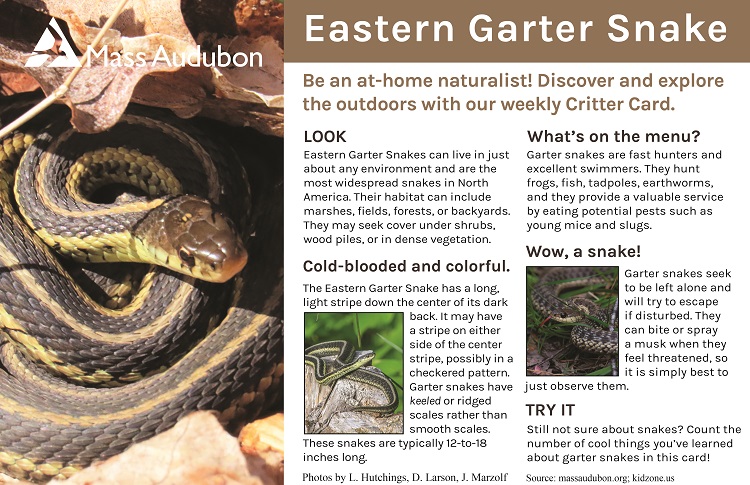
Garter snakes have all these characteristics and utilize them perfectly… in your backyard. Luckily the vast majority of snakes in Massachusetts are non-venomous. As a matter of fact, snakes seeking shelter under stairs, debris, bushes, log piles, and other safe spots in your backyard are signs of a healthy ecosystem. If you find a snake, it’s best to leave it alone to go about its day, and if they stick around they may manage the pests in your yard.

Garter snakes are a group of 30 different species and subspecies that are native to different regions throughout the United States and southern Canada. Here in Massachusetts we’ve named the Common Garter Snake (Thamnophis sirtalis) the state reptile, and subspecies, Eastern Garter Snake (Thamnophis sirtalis sirtalis) is also commonly found throughout the state.
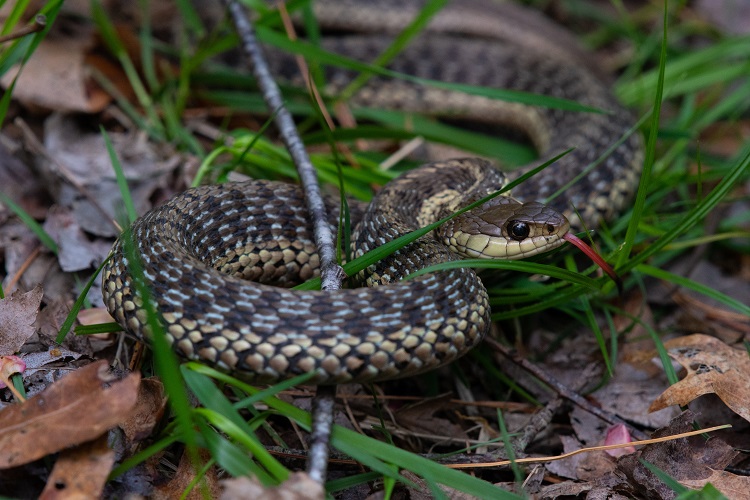
Garter Snake with checkered pattern – Joy Marzolf 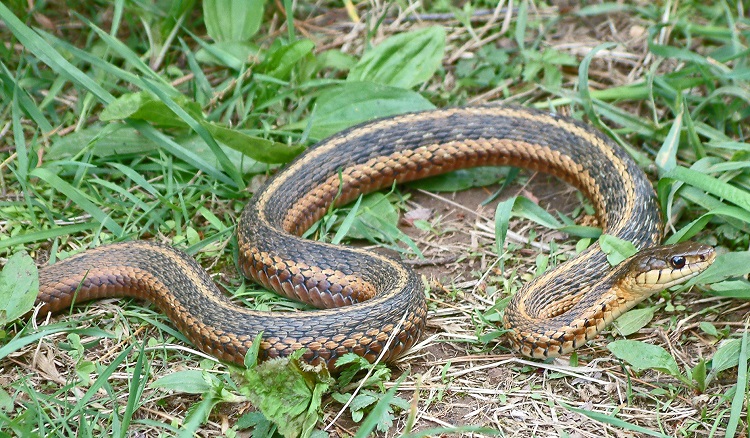
Connecticut Garter Snake – Joy Marzolf 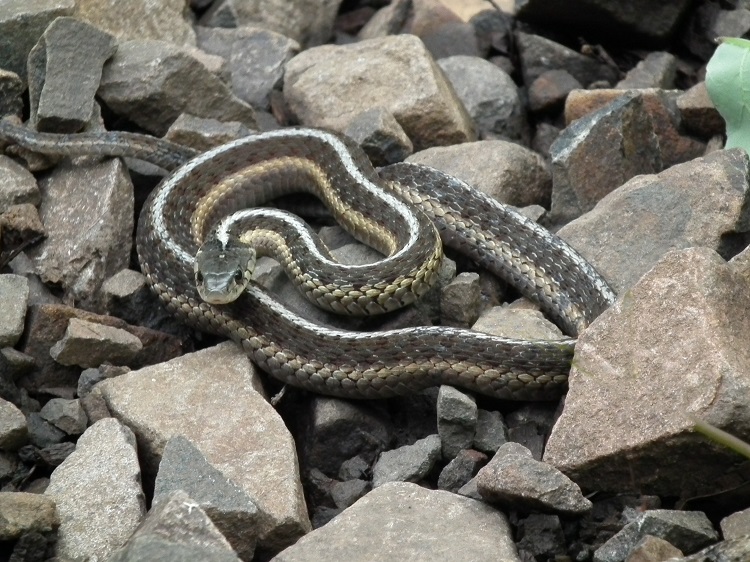
Color variation of Garter Snake – Joy Marzolf
Garter snakes are relatively small, slender snakes that hunt earthworms, amphibians, and fish, but will also take insects, leeches, and small mammals when opportunity allows. An important part of the food web, garter snakes are a natural food source for crows, magpies, hawks, owls, foxes, bears, raccoons, and even skunks. Due to their small size, garter snakes rely on a foul-smelling musk they produce, sharp teeth, and camouflage, to protect them. Because garter snakes can bite when provoked, it’s best to observe and not touch.
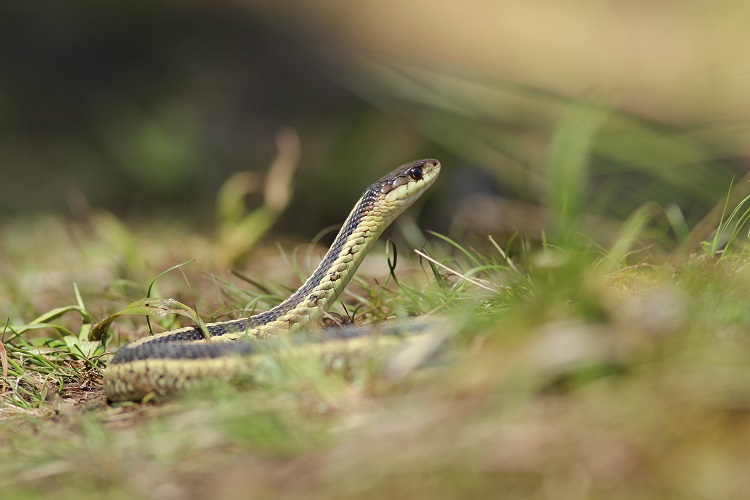
Though they are predominantly terrestrial, garter snakes may occasionally be seen climbing on shrubs or swimming in small bodies of water. Garter snakes in Massachusetts grow on average 18-26 inches, but will occasionally reach lengths of up to 4 feet. Snakes never stop growing and in order to accommodate that growth, they shed their skin. Young snakes will shed a few times a year while they grow quickly, and mature snakes will shed less often.

Cold-climate garter snakes, such as those living in Massachusetts, must hibernate to survive the cold winters. Hibernating in numbers offers a greater chance of success, hence these snakes have communal dens where they come together to co-hibernate. Dozens to hundreds of garter snakes (and often other species as well) will travel great distances to come together during this time, and will often emerge in the spring all together in a group. The largest communal hibernation den found was in Canada and held an incredible 8,000 garter snakes.

In Massachusetts, hibernation also marks the time of mating. As snakes travel to their communal dens, they take advantage of the dense congregation and mate either in the autumn, before hibernation begins, or in the spring when snakes reemerge again. Female snakes, often larger than the males, will release pheromones when they are ready to mate. In warmer areas where these snakes don’t hibernate, males rely on their chemosensation to detect pheromones to help them locate the female. Dozens of males will seek out one female and mate with her, creating a mating ball. Garter snakes are ovivarporous meaning females give birth to live young; on average she will produce 20-40 young snakes, but reports range anywhere from 5 to 101. After giving birth, the young snakes immediately begin their life independently with no parental care.
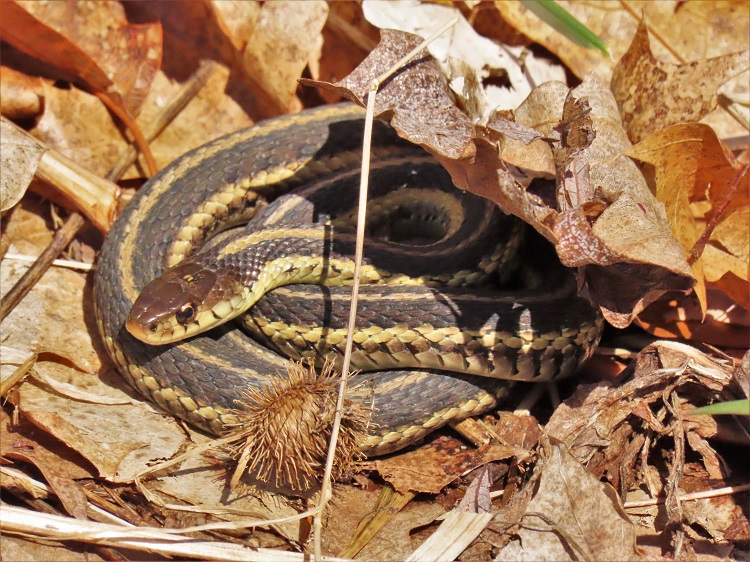
What can you do for garter snakes?
- Try not to disturb the snake while observing its behavior. Watch and see where they go, can you figure out what resource they are going to?
- Provide shelter for snakes. If you want snakes around, and you’re up for a project, building safe spots for them is fun and rewarding. Log or slate piles, rock walls, dense vegetation, large logs, and other “debris” are all good options for hiding from hawks!
- During droughts and hot weather, supply water for snakes in your yard.
- Hold off on mowing. Snakes will hunt their prey in long grass, and seek protection there from their natural predators.
- If you find a snake in a truly inconvenient place, try stomping on the ground. Snakes are deaf, but the vibrations caused by your feet will often drive them away.
Herpetophobia, the fear of reptiles and Ophidiophobia, the fear of snakes are common fears in society. Snakes can produce anxiety for some people which may lead to rash actions. It’s not uncommon to be afraid of snakes, but can you challenge yourself to simply observe one the next time you have an encounter? Maybe we can learn some empathy for these incredible animals, which are truly benign and ecologically important.
Learning Tools from Mass Audubon
Learn about the different snakes species in Massachusetts.
Read about snakes in general.
Read about common encounters and solutions to snake problems, and how to carefully manage this backyard resident.
Looking for More Resources and Activities?
Looking for a book? Try A Guide to Amphibians and Reptiles in the Stokes Nature Guide series.
Five fun facts about Garter Snakes.
Read more about snakes in Massachusetts.
Consider what would happen if snakes went extinct.
Read this article by the Smithsonian Magazine talking about how snakes make friends!
Learn more interesting facts here.
Watch this video to learn more about Garter Snakes and what makes them so interesting.
Watch this video to see the friendly side of snake pets.
Find out more about Garter Snakes for kids!
Research Garter Snakes with maps, worksheets, and other activities.
Craft this fun snake toy, or this colorful spiral snake.
Submissions

What’s Next
What would you like to learn about from your backyard? Let us know in the comments.
Stay tuned for the next Critter Card coming out on Monday, by email and Facebook.
Connect With Us
Would you like to be added to Lisa Hutchings’ VIP email list? Receive special resources such as nature slideshows and educational tools for at-home learning. Send an email to [email protected] requesting to be added to the VIP list.

